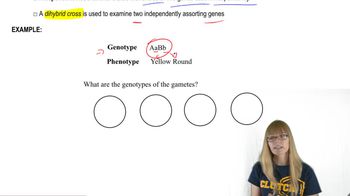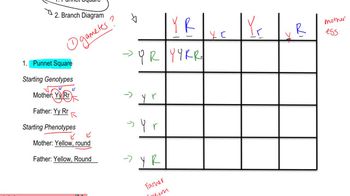Table of contents
- 1. Introduction to Genetics51m
- 2. Mendel's Laws of Inheritance3h 37m
- 3. Extensions to Mendelian Inheritance2h 41m
- 4. Genetic Mapping and Linkage2h 28m
- 5. Genetics of Bacteria and Viruses1h 21m
- 6. Chromosomal Variation1h 48m
- 7. DNA and Chromosome Structure56m
- 8. DNA Replication1h 10m
- 9. Mitosis and Meiosis1h 34m
- 10. Transcription1h 0m
- 11. Translation58m
- 12. Gene Regulation in Prokaryotes1h 19m
- 13. Gene Regulation in Eukaryotes44m
- 14. Genetic Control of Development44m
- 15. Genomes and Genomics1h 50m
- 16. Transposable Elements47m
- 17. Mutation, Repair, and Recombination1h 6m
- 18. Molecular Genetic Tools19m
- 19. Cancer Genetics29m
- 20. Quantitative Genetics1h 26m
- 21. Population Genetics50m
- 22. Evolutionary Genetics29m
2. Mendel's Laws of Inheritance
Dihybrid Cross
Problem 42
Textbook Question
In chickens, the presence of feathers on the legs is due to a dominant allele (F), and the absence of leg feathers is due to a recessive allele (f). The comb on the top of the head can be either pea-shaped, a phenotype that is controlled by a dominant allele (P), or a single comb controlled by a recessive allele (p). The two genes assort independently. Assume that a pure-breeding rooster that has feathered legs and a single comb is crossed with a pure-breeding hen that has no leg feathers and a pea-shaped comb. The F₁ are crossed to produce the F₂. Among the resulting F₂, however, only birds with a single comb and feathered legs are allowed to mate. These chickens mate at random to produce F₃ progeny. What are the expected genotypic and phenotypic ratios among the resulting F₃ progeny?
 Verified step by step guidance
Verified step by step guidance1
Identify the genotypes of the parent chickens: The pure-breeding rooster with feathered legs and a single comb has the genotype FFpp, and the pure-breeding hen with no leg feathers and a pea-shaped comb has the genotype ffPP.
Determine the genotype of the F₁ generation: Since the rooster and hen are pure-breeding, all F₁ offspring will be heterozygous for both traits, resulting in the genotype FfPp.
Cross the F₁ generation to produce the F₂ generation: Perform a dihybrid cross between two FfPp individuals. Use a Punnett square to determine the genotypic and phenotypic ratios of the F₂ generation.
Select the F₂ individuals with a single comb and feathered legs: These individuals have the genotype F_pp. Calculate the proportion of F_pp individuals from the F₂ generation using the results from the Punnett square.
Determine the expected genotypic and phenotypic ratios of the F₃ generation: Since only F_pp individuals are allowed to mate, consider the possible genotypes and phenotypes that can result from F_pp x F_pp crosses.
Recommended similar problem, with video answer:
 Verified Solution
Verified SolutionThis video solution was recommended by our tutors as helpful for the problem above
Video duration:
5mPlay a video:
Was this helpful?
Key Concepts
Here are the essential concepts you must grasp in order to answer the question correctly.
Mendelian Genetics
Mendelian genetics is the study of how traits are inherited through generations based on the principles established by Gregor Mendel. It includes concepts such as dominant and recessive alleles, which determine the expression of traits. In this scenario, the presence of leg feathers and comb shape in chickens is governed by these alleles, illustrating Mendel's laws of inheritance.
Recommended video:
Guided course

Descriptive Genetics
Independent Assortment
The principle of independent assortment states that alleles for different traits segregate independently of one another during gamete formation. This means that the inheritance of one trait, such as leg feathers, does not influence the inheritance of another trait, like comb shape. In the given question, the independent assortment of the F and P alleles allows for a variety of combinations in the offspring.
Recommended video:
Guided course

Gamete Genetics and Independent Assortment
Genotypic and Phenotypic Ratios
Genotypic ratios refer to the relative frequencies of different genotypes in the offspring, while phenotypic ratios refer to the relative frequencies of observable traits. In the context of the F₃ progeny, understanding how to calculate these ratios based on the parental genotypes and the principles of inheritance is crucial for predicting the outcomes of the crosses described in the question.
Recommended video:
Guided course

Gamete Genotypes
Related Videos
Related Practice





